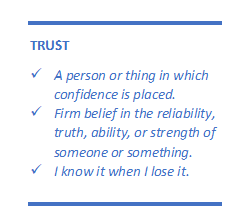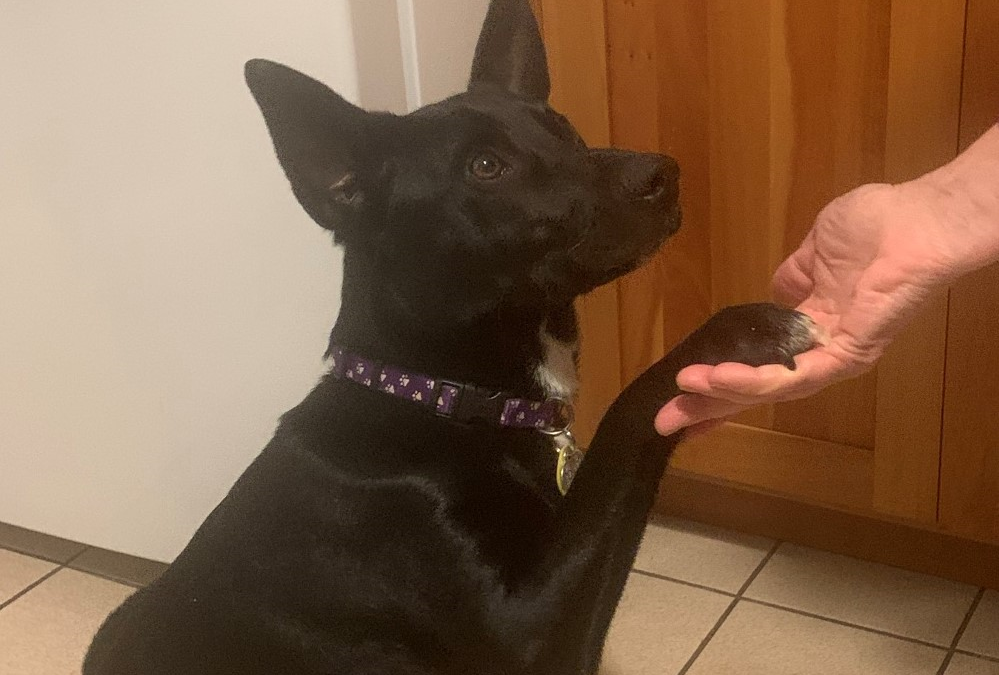Trust in COVID19 times depends on context: circumstances, historical identity, tolerance for risk, comfort with uncertainty, attitude about individual rights and social responsibility, critical thinking & more. Introducing a trust label. Podcast episode here
Proem (Preface)
As we spending much of our time trying to absorb and filter some of the dirty water spewing from the cacophony of COVID-19 stuff, we keep asking, who wrote this? Who said that? When? Is it still true? So what? But what about xxx? It’s exhausting. Who to trust? What to trust? After draining, maddening calls with family and friends who clearly trust something different than us, we feel the cloudy mechanisms of trust, conscious or unconscious. Some people trust Dr. Fauci, others Mr. Trump. Some follow the CDC, others QAnon. What does trust even mean? What is trustworthiness?
 In this piece, we will examine trust. We don’t have the chutzpah, the energy, or the resources to give Seals of Approval for trust. At best we can promote a bit of self-awareness about trust. Picture a family sitting around the breakfast table with a young person waving their tablet and exclaiming, ‘look what I found about mask-wearing!’ Imagine an adult responding, ‘Who wrote that? When was it written? Who paid for it? Did it cite any references? Does it make sense to you?’ We advocate for self-awareness of our own trust faith, filters, and responses.
In this piece, we will examine trust. We don’t have the chutzpah, the energy, or the resources to give Seals of Approval for trust. At best we can promote a bit of self-awareness about trust. Picture a family sitting around the breakfast table with a young person waving their tablet and exclaiming, ‘look what I found about mask-wearing!’ Imagine an adult responding, ‘Who wrote that? When was it written? Who paid for it? Did it cite any references? Does it make sense to you?’ We advocate for self-awareness of our own trust faith, filters, and responses.
Our overriding lesson learned: Trust Is Complicated.
Person-first
 Let’s approach trust using our person-first theme -starting with regular people and meeting them where they are. Person-first includes knowing your audience and end-users and understanding their questions, their circumstances, their preferences, and conditions. People will find information where they usually find information – talking heads, websites and searches, cronies, professionals. They may or may not question what they read, hear, watch. Many will share what they learn and become someone with an apparent 15-minute advantage (knowing just a bit more).
Let’s approach trust using our person-first theme -starting with regular people and meeting them where they are. Person-first includes knowing your audience and end-users and understanding their questions, their circumstances, their preferences, and conditions. People will find information where they usually find information – talking heads, websites and searches, cronies, professionals. They may or may not question what they read, hear, watch. Many will share what they learn and become someone with an apparent 15-minute advantage (knowing just a bit more).
The context of trust
For some trust reveals itself most when they lose it – think about losing trust in a family member, friend, politician, celebrity, or movement or when someone important to you loses trust in you – devastating, a punch in the gut. The inertia is trust until it isn’t. For others, the inertia is mistrust. Trust must be built in a headwind. Show me your trustworthiness. So, trust ferments in a context, a relationship. Let’s try to understand the personal ingredients that flavor the creation of trust. In Covid19-world, personal trust ingredients include understanding an individual’s circumstances, experience, and historical identity, their tolerance for risk, their comfort with uncertainty, their attitude toward individual rights and social responsibilities, and their capacity and willingness to think critically. We’ll examine each ingredient next.
Circumstances, experience, historical identity
Ponder 911. Many people trust that when they call 911, someone will come quickly to help them, whatever the help they need. But if you live in a community where 911 doesn’t come or the help isn’t helpful or is downright lethal, you won’t rust 911. 911 has a long racist history. Many people raise The Tuskegee Syphilis Study as an influence on trusting the medical system. Different circumstances, different experiences, a different history. Trust is complicated.
Risk Tolerance
 Here’s a Covid-19 Risk Tolerance Scale published by the APNA, the Association for Premier Nanny Agencies, ranging from Very Strict to Very Open. Some people, very strict, want to stay in their bubble with people living in the same house and avoid all outside contact. Some, Fairly Strict, may leave home for work and socialize with a mask, physically distant. Still others, Very Open, socialize without masks or physical distance. Self-awareness of your risk tolerance helps to understand the trust of others. Understanding others’ risk tolerance helps to understand of their trust. Trust is complicated.
Here’s a Covid-19 Risk Tolerance Scale published by the APNA, the Association for Premier Nanny Agencies, ranging from Very Strict to Very Open. Some people, very strict, want to stay in their bubble with people living in the same house and avoid all outside contact. Some, Fairly Strict, may leave home for work and socialize with a mask, physically distant. Still others, Very Open, socialize without masks or physical distance. Self-awareness of your risk tolerance helps to understand the trust of others. Understanding others’ risk tolerance helps to understand of their trust. Trust is complicated.
Comfort with uncertainty
We continue to meet our audience and end-users where they are when we understand their comfort with uncertainty. Most people (professional and non-professional) feel more comfortable with certainty than uncertainty. Certainty is a continuum. Certain: The earth is round. I will be safer if I look both ways before I cross a busy street. A bit less certain: I will still have a job tomorrow. Ibuprofen will reduce my fever. Much less certain: I will win the Lotto. I will never contract COVID-19. In our Covid-19 world, certainty seems harder to pin down. Things appear to change every day. We’re repairing the airplane while we’re flying it. Part of comfort with uncertainty is that some people think in black and white (it’s correct or not) and some think in shades of grey (it depends). Perhaps people who think in grey are more comfortable with uncertainty? Knowing where people live on the continuum of comfort with uncertainty helps us understand their trust context. Trust is complicated.
Individual rights and social responsibility
Another continuum relevant to profoundly understanding the context of trust can be represented by individual rights and social responsibility. Those who prize individuals’ liberties to pursue life without others’ interference have a different trust context than those that prize duties or obligations for community cooperation, respect, and participation. It’s my right not to wear a mask versus wear a mask to protect each other. How much will the person that values individual rights over all else trust strict evidence-informed mask-wearing and physical distancing? How will a person that values cooperation and community over all else trust a voice on the other end of the continuum? Trust is complicated.

Critical thinking
Critical thinking, at its root, is curiously, persistently questioning everything. Does this make sense? So what? How does it apply to this situation? Who benefits? Critical thinking, like music, is a skill using many muscles that ne ed practice and exercise. As a patient-caregiver activist, I’m a person who appears to question everything. Yet I’m happy to leave most decisions about my multiple sclerosis to those I trust (my wife, my primary care doc, and neurologist). But without trust, I question everything. My wife, on the other hand, seems to question everything. It’s less about trust and more about comfort. Here’s two models to help with critical thinking: Who, What, Where, When, How and I.N.Q.U.I.R.Y
ed practice and exercise. As a patient-caregiver activist, I’m a person who appears to question everything. Yet I’m happy to leave most decisions about my multiple sclerosis to those I trust (my wife, my primary care doc, and neurologist). But without trust, I question everything. My wife, on the other hand, seems to question everything. It’s less about trust and more about comfort. Here’s two models to help with critical thinking: Who, What, Where, When, How and I.N.Q.U.I.R.Y
Trust is complicated.
Trustworthy versus factual
Once we meet people where they are and understand their risk tolerance, comfort with uncertainty, attitude toward individual rights and social responsibility, and willingness and capacity to think critically, then we bump up against the dilemma of trustworthy and factual. They’re different. A simple definition of factual is verifiable – data that is verifiable – getting the same results repeatedly. Yet COVID-19 facts – really almost all facts – seldom stand alone. Interpretation and commentary are constant companions to facts. What do facts mean to me, to my community? That’s where trust comes in. Interpretation and commentary. Trust is complicated.
Trust label
 Likely, you still ask, this context stuff is all well and good, makes sense, but who and what should I trust as I make decisions for safe living in a pandemic? Point me in the right direction. Remember that we started with We don’t have the chutzpah, the energy, or the resources to give Seals of Approval for trust. Instead, we became drawn to the nutrition label model. Most people don’t use nutrition labels, but those that do use the nutrition label to make food selection decisions. Most people who use nutrition labels trust them. Why? For those people concerned about their diet, the nutrition offers some factual information about the food package contents. It makes no claim to healthiness or taste. A person needs to want to know about the contents and interpret the calories, sugar, fat, fiber for themselves. See the label here for macaroni and cheese. You can see serving size, calories, nutrients and fiber, and percent of the daily value. Perhaps, a trust label could offer some facts about answering resources that the end-user can interpret for themselves.
Likely, you still ask, this context stuff is all well and good, makes sense, but who and what should I trust as I make decisions for safe living in a pandemic? Point me in the right direction. Remember that we started with We don’t have the chutzpah, the energy, or the resources to give Seals of Approval for trust. Instead, we became drawn to the nutrition label model. Most people don’t use nutrition labels, but those that do use the nutrition label to make food selection decisions. Most people who use nutrition labels trust them. Why? For those people concerned about their diet, the nutrition offers some factual information about the food package contents. It makes no claim to healthiness or taste. A person needs to want to know about the contents and interpret the calories, sugar, fat, fiber for themselves. See the label here for macaroni and cheese. You can see serving size, calories, nutrients and fiber, and percent of the daily value. Perhaps, a trust label could offer some facts about answering resources that the end-user can interpret for themselves.
 In this table you can see some of the questions we sought to answer with a trust label and some fields that could be easily attached to the answering resource. Perhaps you’re thinking that a trust label seems underwhelming, too simple. Well, the creation of the nutrition label was a big ask. The nutrition label history runs from a White House Conference on Food, Nutrition, and Health in 1969 to the passing of the Nutrition Labeling and Education Act in 1990, 21 years. The evolution of values and standards continued through the 1990s, 30 years. Trust is complicated.
In this table you can see some of the questions we sought to answer with a trust label and some fields that could be easily attached to the answering resource. Perhaps you’re thinking that a trust label seems underwhelming, too simple. Well, the creation of the nutrition label was a big ask. The nutrition label history runs from a White House Conference on Food, Nutrition, and Health in 1969 to the passing of the Nutrition Labeling and Education Act in 1990, 21 years. The evolution of values and standards continued through the 1990s, 30 years. Trust is complicated.
Now what? Next steps.
So, we have taken some baby steps: standing up a library, a repository, a website with person-facing resources containing a trust label so people can more easily seek and share answers to their questions about safe living in a pandemic. Join us. Help us enter answering resources using this Google Form. We built a website safeliving.tech to house our materials. Talk to us here info@safeliving.tech. Our next step will be summarizing our work for regular people, clinicians, and knowledge management professionals and hosting some virtual spaces to chat about this work. Trust is complicated. Safe living is complicated.
Resources about trust in safe living info
- Review criteria for news stories and PR from HealthNewsReview.org
- Stronger. The truth is worth fighting for. Stopping the spread of misinformation by advocating for facts, science, and vaccines.
- CDC’s Program Performance and Evaluation Office
- EBSCO Information and Resources to Help During the COVID-19 Pandemic
- COVID Resources
- British Medical Journal’s GRADE (Grading of Recommendations, Assessment, Development and Evaluations) is a transparent framework for developing and presenting summaries of evidence and provides a systematic approach for making clinical practice recommendations.
- Trusting News: Helping journalists earn news consumers’ trust.
CDC initiative Adapting Clinical Guidelines for the Digital Age
EBSCO to use their Stacks Content Management System
Patient-Centered Clinical Decision Support-Learning Network.
CDS Trust framework: 9 trust attributes = trust is complicated.
Want to enroll somehow? Know of a place for us to cross-post our print, video, or audio stories? Communicate with us here info@safeliving.tech, #safelivingpandemic on Twitter, or https://www.safeliving.tech/







Thank you and will keep the advice on who is to trust first people during this pandemic crisis.